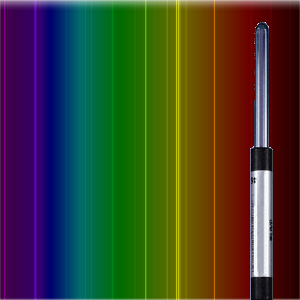
Mercury Calibration Source
- Narrow, Discrete Spectral Lines
- Excellent Stability
- Long Life
- Fits to McPherson 5" Slits
Mercury calibration lamps are small, rugged, and easy to use. Because the lamps operate at low pressure, well spaced, intrinsically narrow and bright Mercury emission lines dominate the output spectrum. Background between the lines is very low. The output wavelengths are known exactly and are ideal for spectral calibration. Single lines are easily isolated with optical filters for alignment or other applications. Closely spaced lines are very useful for testing the resolution of dispersive instruments.
Mercury spectral calibration lamps make excellent high intensity short wave UV sources too. About 90% of the total output is in the 253.65nm emission line. Appropriate UV eye safety measures are required. The visible lines are intense and useful for calibration of McPherson spectrometers.
Model 625 PDF Data Sheet
Additional Information:
| Source | Low pressure Hg pencil-type lamp |
| Source Emission | Discrete, Narrow, Intense Line Emission |
| Typical Intensity at 253.65nm | 4400 uW/cm2 at 0.75inch distance |
| Image Size | approx 3mm x 20mm high |
| Power Supply | AC, 110V and 220V versions available |
| Rated Lamp Life | 5000 hours |
| Size | 5" dia x 1" long |
| Weight | 1 lbs |
Outline Drawing

Select Publications
Abstract:
The wavelengths of 19 spectral lines in the region 253 - 579 nanometers emitted by Hg pencil-type lamps were measured by Fourier-transform spectroscopy. Precise calibration of the spectra was obtained with wavelengths of Hg as external standards. Our recommended values should be useful as wavelength calibration standards for moderate-resolution spectrometers at an uncertainty level of 0. 0001 nm.
Craig J. Sansonetti, Marc L. Salit, and Joseph Reader
Abstract:
The irradiances of 37 spectral lines eitted by mercury pencil type lamps were measured by comparison with calibrated continuum sources. The lines span the region 230 - 590 nanometers. For the 14 most prominent lines the absolute irradiances should be useful for radiometric calibration at an uncertainty level of 15% (95% confidence). The raios of the irradiance for this same group of lines are significantly more reproducible; they should be useful at an uncertainty level of 10%.
Joseph Reader, Craig J. Sansonetti, and J. Mervin Bridges
